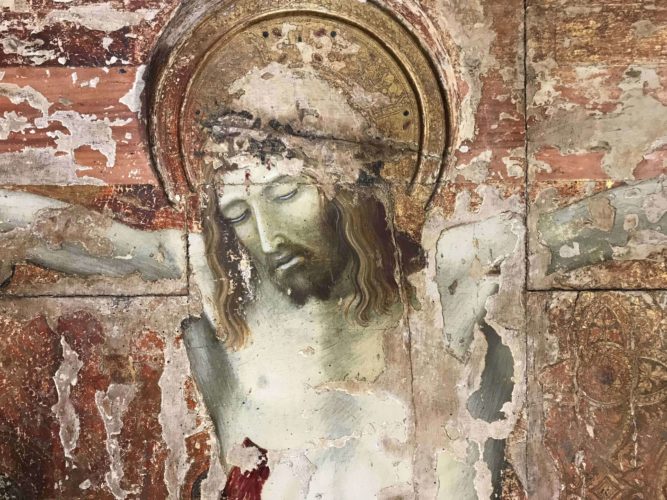Lorenzetti Crucifix Restored Thanks to Friends of Florence

The first phase of restoration of Ambrogio Lorenzetti’s Crucifix of Carmine has been completed in Florence.
The artist, Ambrogio Lorenzetti created the crucifix for the church San Niccolò del Carmine in Siena in the 1330s. A pre-renaissance work of art, Lorenzetti’s work had been preserved until water damage in the 19th century severely ruined the color, flaking off large pieces of paint in the process. Despite the damage, the face of Christ was protected by the figure’s protruding halo which managed to block some of the water. To preserve the work of art, it was moved to Siena’s Pinacoteca Nazionale, where it has continuously stayed, bar its restoration periods, the first of which occurred in the late 1930s. Yet, the restoration was not complete and less than 20 years later in 1953, a second restoration began by the Istituto Centrale per il Restauro (ICR) in Rome. The institute managed to recover many of the work’s original sections by removing parts that had been repainted throughout the centuries, substituting a neutral color process called chromatic abstraction.
Almost seven decades later, the regional direction for the museums of Tuscany, thanks to a donation from non-profit organization Friends of Florence, have decided to restore the piece once again. Though the restoration in the 1950s helped prevent further damage, the work has since lost some of its original definition. In May 2020, Lorenzetti’s crucifix was transferred to Florence where, headed by restorer Muriel Vervat, the first stage of the new restoration was completed. In the last year, restorers managed to analyze the extremely precious materials that were originally used by Lorenzetti such as gold and silver leaf. When it had been restored in the 1950s, the restorers had put a transparent coating over such sections. Now, thanks to modern techniques and analysis, the original pigments have been re-implemented into the work.
Born in Siena at the end of the 13th century, Ambrogio Lorenzetti was an artist of the Sienese school alongside other pivotal artists such as his brother Pietro and Simone Martini. Though Lorenzetti and his artistic peers lived during the Gothic period, they were often inspired by Byzantine art, shown by their use of naturalist techniques. Lorenzetti’s use of naturalist colors, light and shadow showed a transitional style and is considered a precursor to early Renaissance art.
For many centuries, the Crucifix del Carmine was thought to be the work of Ambrogio’s younger brother, Pietro, however it has since been attributed to Ambrogio as the rightful artist. The dramatic chiaroscuro and coloring of Christ on the Crucifix was one of Lorenzetti’s naturalist techniques, evident by the pale blue paint on the figure’s lips signaling death and the humble placement of the bowed head and folded knees, Lorenzetti’s interpretation is symbolic of the inherent humanity in Christ’s passing.
Throughout his life, Lorenzetti also visited Florence, where he would have been inspired by Giotto, yet another influential artist whose work is reminiscent of both Gothic and Renaissance styles. Similar to Giotto, Lorenzetti was known for his grand frescoes, particularly The Allegory of the Good and Bad Government, three fresco panels painted by Lorenzetti in the mid 14th century and located in Siena’s Palazzo Pubblico. It is a notable work of art, especially for its time period, as its civic message is symbolic of the emerging world of secular Renaissance art and humanist ideas. (mirabella shahidullah)
